
By far one of the most colorful and diverse groups of animals in the sea is that of the coral reef fishes. Their extensive range of bright colors and bold patterns is virtually unmatched in the entire undersea kingdom. And although they may be beautiful to behold, there is a real function behind each of these designs. Red colors appear black under water, helping a fish to go unseen. Stripes allow a fish to camouflage itself against the coral. Spotted patterns serve to confuse a would-be predator. Each species of fish deals with survival in its own way, and we are left to wonder at their accomplishments. Below is a listing of some of the more common coral reef fishes. Most of these species are suitable for the home aquarium. By the way, contrary to popular belief, it is perfectly acceptable to use the term "fishes" when referring to many different species at once. But you must still use the word "fish" when talking about members of the same species or members of a single group.
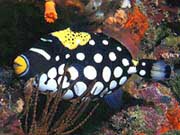
The clown triggerfish is without a doubt the most beautiful member of the trigger family. The bright yellow mouth is believed to deter potential predators. As with most other triggers, the clown is an aggressive feeder, feeding mainly on crustaceans and mollusks. They use their strong jaws to crack open the shells of mollusks and crabs.
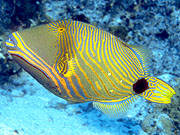
The orange-green triggerfish is actually the most aggressive of all the trigger species. Their strong jaws can reduce the hard shells of stony corals to piles of sand. Their striking colors can vary quite considerably. Indian ocean variants have orange tails while Pacific Ocean versions can have orange-rayed fins. They grow to a length of about 12 inches.
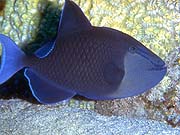
The black triggerfish is one of the less aggressive trigger species. Because of this they usually make good additions to the home aquarium. They have red teeth, and their color can actually vary from blue to green from day to day. As with most triggers, they eat mollusks and crustaceans and it is not recommended to mix them with invertebrates in the aquarium.
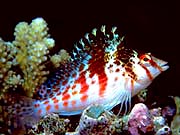
Hawkfishes are a group of coral reef fishes that have a peculiar habit of resting or perching on corals and rocks as they wait for their prey. They feed on shrimps and small fish. They are not very good swimmers, and their comic antics make them an enjoyable addition to the home aquarium. This species is characterized by the vertical red stripes, which help with camouflage.
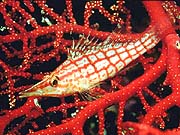
The longnosed hawkfish is characterized by an elongated body and square pattern of red markings. It uses its long snout to probe into coral crevices for food. The color pattern of this fish helps to conceal it while it rests amongst the corals. It will sit still and wait for a convenient meal to wander by.
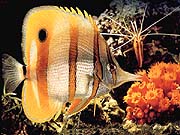
The copper-band butterfly fish is a beautiful and elegant species. the large black spot on the back of the upper body looks like an eye and helps to confuse predators. This fish uses its long snout to pick out and feed on coral polyps and tube worms. It is a popular aquarium species, but is delicate and difficult to keep alive.
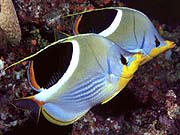
The saddleback butterflyfish is characterized by the large black marking on its back which somewhat resembles a saddle. The shape of this species resembles that of some angelfish species. The saddleback is not recommended for an invertebrate aquarium, as they will feed on coral polyps and crustaceans.
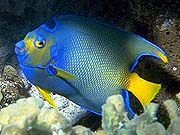
The queen angelfish is without a doubt the most beautiful of the angelfish species. Young queens resemble a juvenile blue angelfish. But as they grow, they acquire their spectacular blue and yellow markings, with rainbow colors on the edges of their fins. The queen angelfish is found throughout the western Atlantic. It is a grazer, feeding on algae, sponges, and coral.
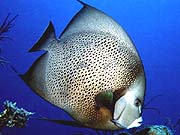
As with many angelfish species, the gray angelfish undergoes a color change as it grows. The juveniles are black with vertical yellow stripes. As it matures, it looses its color and takes on the grayish appearance of the adult. This angelfish is found in the waters of the Atlantic and Caribbean, where it feeds on algae & sponges.
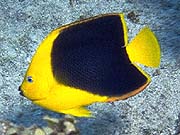
The rock beauty angelfish is characterized by its black and bright yellow colors. The juvenile of the species is yellow with a small dark spot. In the wild, this species grows to about 2 feet in length. Rock beauties are found in the western Atlantic, where they feed on algae, sponges and coral polyps.
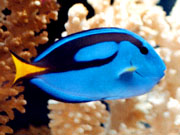
The regal tang, also known as a hippo tang, is characterized by its contrasting black and almost neon blue colors. The tail of this species is marked by a bright yellow wedge. Regal tangs are shy algae eaters. The can grow to about 10 inches in length, and their bright color makes them highly desired by aquarium hobbyists.
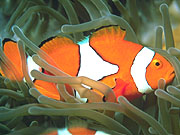
The percula is one of the most beautiful of the clownfish species. The contrasting orange, white, and black colors make it a favorite among aquarium hobbyists. The percula is found in the waters of the Indo-Pacific, where it feeds on plankton and small crustaceans. Like all clownfishes, it will make its home in the tentacles of several anemone species.
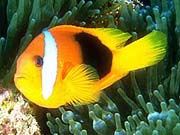
The tomato clownfish is characterized by its single white stripe behind its head, and the dark patch on the rear part of its body. Like all clownfish, the tomato clown can usually be seen darting in and out of the tentacles of a sea anemone. Tomato clowns are found in the waters of the Pacific and Indo-Pacific.
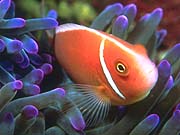
The pink skunk clownfish is identified by its soft, pale pink color and the single white band behind its head. Found in the Pacific Ocean, this clownfish feeds on plankton and small crustaceans. Clownfishes are very aggressive and territorial. These small 3-inch fish have been known to attach sharks and divers who wander too close to their host anemone.
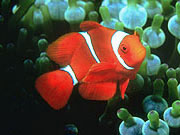
The maroon clownfish is one of the largest clownfish species. It can grow up to 6 inches in length. The color of this species ranges from bright orange to rusty brown, to almost black. Maroons are found in the Pacific Ocean where they are usually seen hiding in the stinging embrace of a large sea anemone.
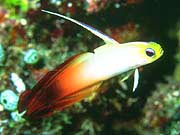
Firefishes are characterized by their bright colors and by their unusually elongated dorsal fin. This fin is used as a signaling device to communicate with other firefishes. It is also used by the fish to wedge itself into small crevasses as a means of protection from predators. Firefishes are found throughout the Indo-Pacific.
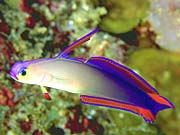
The purple firefish gets its name from its bright purple and red markings. Like other firefish species, it has an elongated dorsal fin that is used for signaling other firefishes and for locking itself into holes and crevasses. Firefishes are bottom feeders, eating plankton and small crustaceans. They grow to a length of about 2 inches.
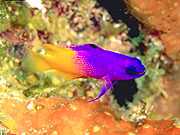
The royal gramma is a beautiful coral reef fish found only in Caribbean reefs. This fish is very shy and secretive, and feeds on drifting plankton and small crustaceans. The yellow and purple coloration of this species appears darker underwater, helping the fish to blend in with its surroundings. Royal grammas are found throughout the western Atlantic Ocean.
Sponges & Sea Squirts | Corals & Anemones | Sea Worms | Echinoderms
Crustaceans | Mollusks | Coral Reef Fishes | Unusual Reef Fishes
Sharks & Rays | Marine Reptiles | Marine Mammals